PRINCETON, NJ -- While the substantial majority of Americans rate their mental health today as excellent or good, there are significant variations in this self-reported mental health measure by one's socioeconomic position. Those with higher incomes are much more likely than those with lower incomes to report excellent mental health, and this relationship persists even when other variables such as age, education, gender, and marital status are taken into account.
Basic Mental Health
Forty-five percent of Americans rate their mental health or emotional well-being at this time as excellent, with most of the rest saying it is "good." There has been little change in the distribution of self-reported mental health over the past seven years in which Gallup has included this measure in its November Gallup Poll Social Series survey on Health.
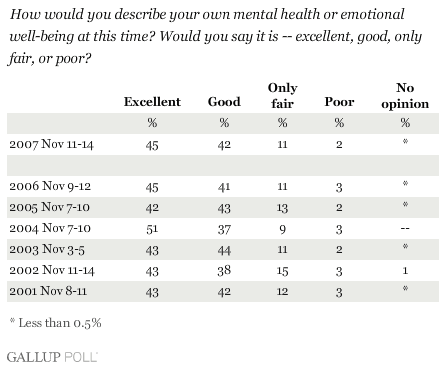
Differences by Subgroup
As is the case for self-reports of one's physical health (see Related Items), there are significant differences in self-reported mental health across various demographic subgroups within the American population. This conclusion, and the analysis that follows, is based on aggregated survey results from the Gallup Poll Social Series Health surveys for the last four years.

There are differences in the percentages rating their mental health as "excellent" across most of these groups -- in some cases, the differences are quite substantial. In general, the groups with the highest levels of reported "excellent" mental health include:
- those with higher incomes
- whites
- men
- those who either are currently married, or have never married
- those who attend church more often
- those who are college educated
- those who are younger
The Persistent Impact of Income
The differences in self-reported excellent mental health by income category are some of the largest measured -- stretching from 27% of those making under $20,000 a year who say their mental health is excellent to 58% of those making $75,000 or more.
It is known that income correlates with a number of other social and demographic variables, including a negative correlation with age (i.e., older Americans on average have lower incomes than those who are middle-aged and young) and a positive correlation with education.
Thus, the accompanying graphs display the relationship between income and self-reported mental health within categories created by other demographic variables. For each of the categories of variables shown, the graphs display the percentage reporting "excellent" mental health among those making under $50,000 a year and among those making $50,000 a year and more.
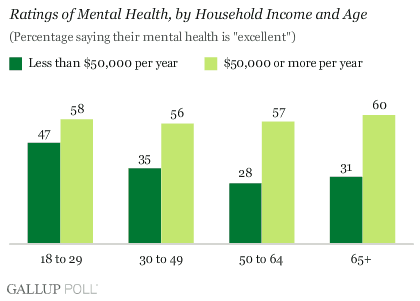

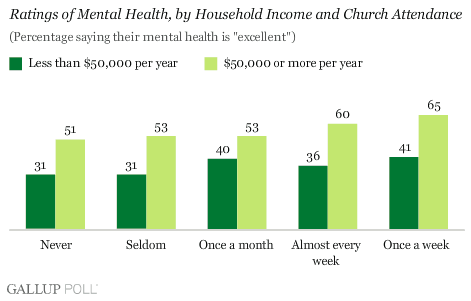
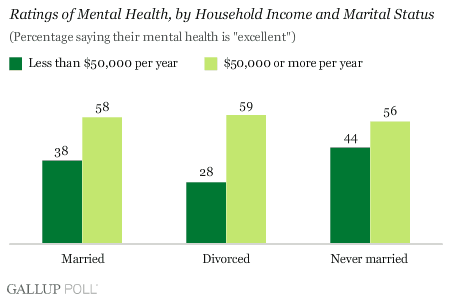
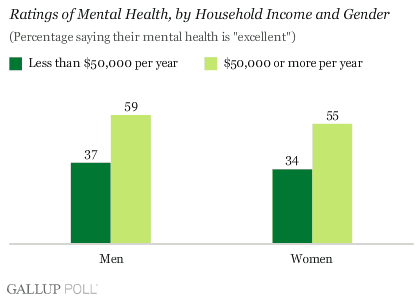
In each of these instances, the impact of income on self-reported "excellent" mental health is similar within the various categories of the variables under consideration. In other words, it appears as if income has an independent relationship with excellent mental health regardless of one's gender, education, church attendance patterns, age, or marital status.
Bottom Line
Most Americans report at least "good" mental health, with almost half saying their mental health is "excellent." But there are significant variations in those who are, and who are not, the most likely to say they are in excellent mental health. One of the most persistent such relationships is income. Despite the old saying that "money can't buy happiness," it does appear that having a higher income is strongly related to having excellent mental health. Even when education, gender, age, church attendance, and marital status are controlled for, those with higher incomes are more likely than those with lower incomes to report excellent mental health.
Survey Methods
These results are based on telephone interviews with a randomly selected national sample of 1,014 adults, aged 18 and older, conducted Nov. 11-14, 2007. For results based on this sample, one can say with 95% confidence that the maximum error attributable to sampling and other random effects is ±3 percentage points. In addition to sampling error, question wording and practical difficulties in conducting surveys can introduce error or bias into the findings of public opinion polls.
